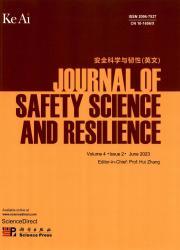提高压缩空气泡沫喷嘴泡沫喷射范围的实验研究
IF 3.4
Q1 PUBLIC, ENVIRONMENTAL & OCCUPATIONAL HEALTH
引用次数: 0
摘要
特高压变压器作为电力系统的核心设备,具有很高的火灾危险性。压缩空气泡沫喷管是一种新型的末端释放装置,由于其高效、优异的油基火灾灭火效果,在特高压变电站中得到越来越多的应用。本研究基于自行开发的压缩空气泡沫灭火系统实验平台。为满足工程实际需要,选取阈值为12 L/(min·m²)的等高线纵向最大值作为喷涂范围。系统地探讨了影响喷嘴喷射范围的因素。实验结果表明,当孔仰角为60°时,平均喷雾距离比0°时增加了59%。当喷嘴孔径为10 mm,出口压力为0.15 MPa时,喷雾范围提高了17%。此外,随着出口压力的增加,泡沫喷射范围显著增大,在0.3 MPa时泡沫喷射范围比0.1 MPa增大35.2%,说明出口压力对喷雾范围有较大影响。为了预测喷雾范围的增加,建立了出口压力与喷雾范围的经验模型。在对上述三种影响因素进行分析后,将各种工况下的所有数据整合为一个数据集,建立喷雾范围的预测模型,并对影响范围的因素进行重要性排序。研究结果为压缩空气泡沫系统的优化设计和工程应用提供了理论依据。本文章由计算机程序翻译,如有差异,请以英文原文为准。
Experimental study on enhancing the foam spray range of compressed air foam nozzle
As the core equipment in power systems, ultra-high voltage (UHV) transformers pose a high fire risk. The compressed-air foam spray nozzle is a novel end-release device that, due to its high efficiency and excellent suppression effect on oil-based fires, has been increasingly applied in UHV substations. This study is based on a self-developed experimental platform for compressed-air foam firefighting systems. To meet practical engineering needs, the longitudinal maximum of the contour line at the threshold of 12 L/(min·m²) was selected as the spray range. The study systematically explored the factors influencing the spray range of the spray nozzle. Experimental results revealed that when the hole elevation angle was 60°, the average spray range increased by 59 % compared to 0°. When the nozzle aperture was 10 mm and the outlet pressure was 0.15 MPa, the spray range improved by 17 %. Additionally, as the outlet pressure increased, the foam spray range grew significantly, with a 35.2 % increase at 0.3 MPa compared to 0.1 MPa, indicating that the outlet pressure had a substantial effect on the spray range. To predict the spray range increase, an empirical model is developed for the outlet pressure versus the spray range. After analyzing the above three influencing factors, all the data of various working conditions were integrated into a single dataset, a prediction model of the spray range was established, and the importance of the factors affecting the range was ranked. These findings provide a theoretical foundation for the optimized design and engineering application of compressed-air foam systems (CAFSs).
求助全文
通过发布文献求助,成功后即可免费获取论文全文。
去求助
来源期刊

安全科学与韧性(英文)
Management Science and Operations Research, Safety, Risk, Reliability and Quality, Safety Research
CiteScore
8.70
自引率
0.00%
发文量
0
审稿时长
72 days
 求助内容:
求助内容: 应助结果提醒方式:
应助结果提醒方式:


